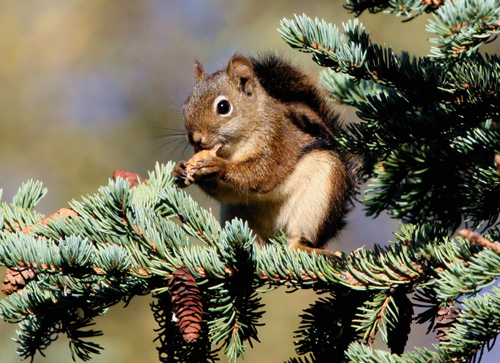Red Squirrels are not as abundant in Connecticut as are Eastern Gray squirrels, but they are still common. They have red-brown fur often brighter down their back. The underbelly fur is whitish. They have a long, bushy tail that is thinner than the Eastern Gray Squirrel's tail. The tail is red-brown and edged with a black band. A black stripe is visble between the red top fur and white lower fur in the winter months. There are fur tufts on the tips of the ears in winter. These squirrels are small, weighing about 5 to 9 oz.
Red squirrels range through the northeastern quarter of the US, through most of Canada and Alaska and in some areas in the Rockies. They live in forested areas with mixed deciduous trees and conifers. They are active year-round, but may stay in a sheltered nest during bad weather. They will nest in tree cavities and build warm-weather leaf nests that look like wads of leaves stuffed in the treetops. In the winter they make systems of tunnels under the snow cover. They will travel from their nests to food sources in these tunnels to avoid many predators.
The red squirrel's favorite food are the seeds of the green cones from evergreen trees. They almost always live near spruce, fir, pine or hemlock trees because of the cones. They will also eat tree nuts such as acorns and beech nuts, seeds, berries, fungus, eggs or even baby birds. For winter food sources, these squirrels will bury some individual nuts like the Eastern Gray squirrel does, but mostly they build up large caches of food which is buried, tucked under logs or stashed in tree cavities. Buried green cones don't dry out before the squirrel wants to eat them. Large piles of cones near a log are a sign of a red squirrel cache. Fungus pieces are placed high in tree branches and cached when they have dried. This avoids spoilage.
Red squirrels mate in late-winter or early spring, and bear a litter in April or May.
Red Squirrels are solitary and very territorial and put alot of effort into marking their territory by biting or rubbing scent glands on the sides of their faces on tree surfaces. They are very vocal, making a ruckus with chatterings and trills.
Neat Fact
Red Squirrels tap sugar maples trees in the spring by nibbling holes in the bark. The sap, which is about 2% sugar, runs out and dries. As water evaporates, the residue left behind is about 55% sugar. The Red Squirrels return to eat the sweet treat.
